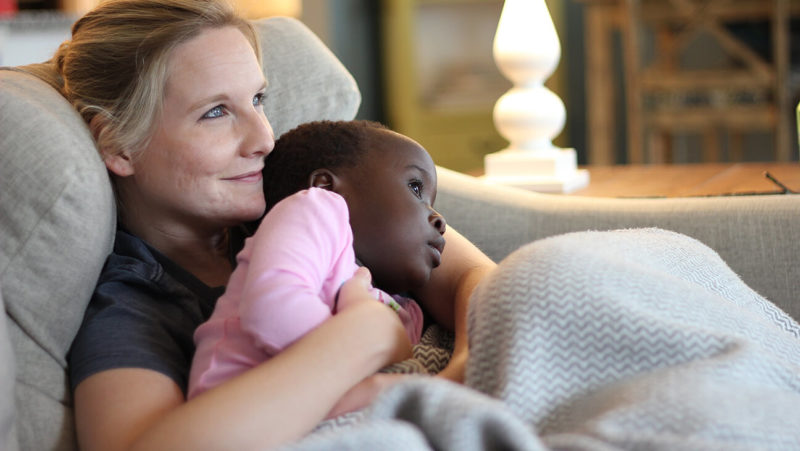Bedtime Struggles & Adopted Kids

Nighttime can bring up so many emotions! For adopted children, it can be an especially difficult time—it’s very common for adopted kids to struggle at bedtime. When you begin to think about your child’s history, it’s not difficult to understand why bedtime can be a challenge. Many children have been living in institutions and haven’t had their own room ever or in a long time. This may cause some kids to feel separation anxiety. Most adopted children have also suffered trauma that they haven’t healed from and find themselves in an unfamiliar place. This may cause children to feel vulnerable which can make feelings of abandonment or loss more pronounced. For children who have adapted to a fight or flight state, the loss of control while they sleep may also create fears that make bedtime feel scary for them. And most importantly, many adopted kids have lacked the type of consistent care and guidance they need through infancy to develop the skills to self-regulate.
When in a family setting, infants are soothed when they have needs. They learn that those needs will be met, and ultimately, they learn to soothe themselves. But children who grow up in unpredictable environments need help developing this skill. For all these reasons (not to mention jetlag!), bedtime can be a struggle.
Here are a few ways you can help your adopted child struggle less at bedtime:
1. Anticipate your child’s needs.
Adopted children benefit from help with learning to identify their emotional and physical needs, and how to meet them. You can ask them what they need or how they are feeling to encourage your child’s self-awareness and eventually, self-regulation. If you know your child grieves their loss at bedtime, reassure them that you love them and are close by if they need you. Leave a light on, a door open, or music playing to help them feel less lonely. You can also encourage your child to snuggle with something familiar and comforting like a toy or blanket that they’ll find soothing if they wake up in the night. In considering their physical needs, think about their comfort. Is the room temperature right for them? Are they going to bed hungry or thirsty? Could there be any medical reasons for bedtime struggles such as food allergies that can lead to restlessness or insomnia, teething, or an ear infection? Anticipating these types of needs can go a long way at bedtime.
2. Establish predictable routines.
A great way to establish felt safety for a child who has experienced trauma is to develop a calming, ritualized bedtime routine. Predictability can help adopted children anticipate and thereby feel control over their day which contributes to a sense of stability. Bedtime routines can include warm baths, bedtime stories, or music. Creating picture charts of their bedtime routine can also be a great tool to help your child internalize the routine and empower them to follow it with minimal reminders.
3. Ensure they’re getting enough sleep.
Young children typically need 10-12 hours of sleep each night. If your child takes a long time to fall asleep, wakes up multiple times in the night, or rises with minimal light or noise in the mornings, you should take that into account when planning their bedtime. Maybe bedtime routines should start earlier or include a transition period before your child sleeps on their own. You may need to sleep in the same bed for the first few weeks, then on a mattress in their room, and then just outside their door. If your child wakes in the night, comfort them but keep the focus on falling back asleep. Don’t introduce a conversation or activity. A good rule of thumb is to be as physically and emotionally present as your child needs you to be but keep that presence as limited as they will tolerate.
4. Practice calming strategies during the day.
Adopted children need opportunities to heal from past trauma. Calming strategies can help but the time to learn them is during the day, ideally while your child is relaxed so that they are ready to use these strategies during more stressful moments, like bedtime. Blowing up balloons with long, slow breaths, yoga, puzzles, coloring, or reading, are all great calming activities to practice with your child. Once calm, healing exercises such as reading adoption-related stories are good starting points for helping your child process feelings of loss and separation. Then, if those feelings become more pronounced at bedtime, your child can fall back on the calming strategies they learned, to self-regulate.
5. Exercise and sensory breaks are necessary.
Don’t underestimate the importance of stretches, jumping jacks, swinging, obstacle courses, bike rides, or tumbling. Daily movement is necessary for young children to release pent-up energy, so it’s important to include physical activity throughout your child’s day. However, this should be balanced with quiet time. Especially for children with sensory sensitivities. Most of us require transitions between physically active and calming parts of our day. This is especially true at bedtime. Sensory stimulation can occur through movement, temperature, noise, textures, or light, and sensory breaks can be very helpful for getting your child ready for sleep.
Your child may not have developed ideal associations with bedtime before finding you but it’s not too late. Love, patience, and these tips can help your child heal and grow to love the sense of peace and safety that you strive to provide.